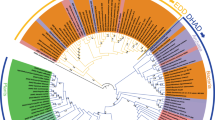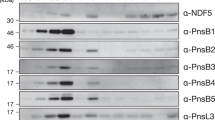Abstract
The photosynthetic protist Euglena gracilis is one of few organisms known to possess both class-I and class-II fructose-1,6-bisphosphate aldolases (FBA). We have isolated cDNA clones encoding the precursor of chloroplast class-I FBA and cytosolic class-II FBA from Euglena. Chloroplast class-I FBA is encoded as a single subunit rather than as a polyprotein, its deduced transit peptide of 139 amino acids possesses structural motifs neccessary for precursor import across Euglena's three outer chloroplast membranes. Evolutionary analyses reveal that the class-I FBA of Euglena was recruited to the chloroplast independently from the chloroplast class-I FBA of chlorophytes and may derive from the cytosolic homologue of the secondary chlorophytic endosymbiont. Two distinct subfamilies of class-II FBA genes are shown to exist in eubacteria, which can be traced to an ancient gene duplication which occurred in the common ancestor of contemporary gram-positive and proteobacterial lineages. Subsequent duplications involving eubacterial class-II FBA genes resulted in functional specialization of the encoded products for substrates other than fructose-1,6-bisphosphate. Class-II FBA genes of Euglena and ascomycetes are shown to be of eubacterial origin, having been acquired via endosymbiotic gene transfer, probably from the antecedants of mitochondria. The data provide evidence for the chimaeric nature of eukaryotic genomes.
Similar content being viewed by others
Author information
Authors and Affiliations
Additional information
Received: 20 December 1996 / 5 February 1997
Rights and permissions
About this article
Cite this article
Plaumann, M., Pelzer-Reith, B., Martin, W. et al. Multiple recruitment of class-I aldolase to chloroplasts and eubacterial origin of eukaryotic class-II aldolases revealed by cDNAs from Euglena gracilis. Curr Genet 31, 430–438 (1997). https://doi.org/10.1007/s002940050226
Issue Date:
DOI: https://doi.org/10.1007/s002940050226




